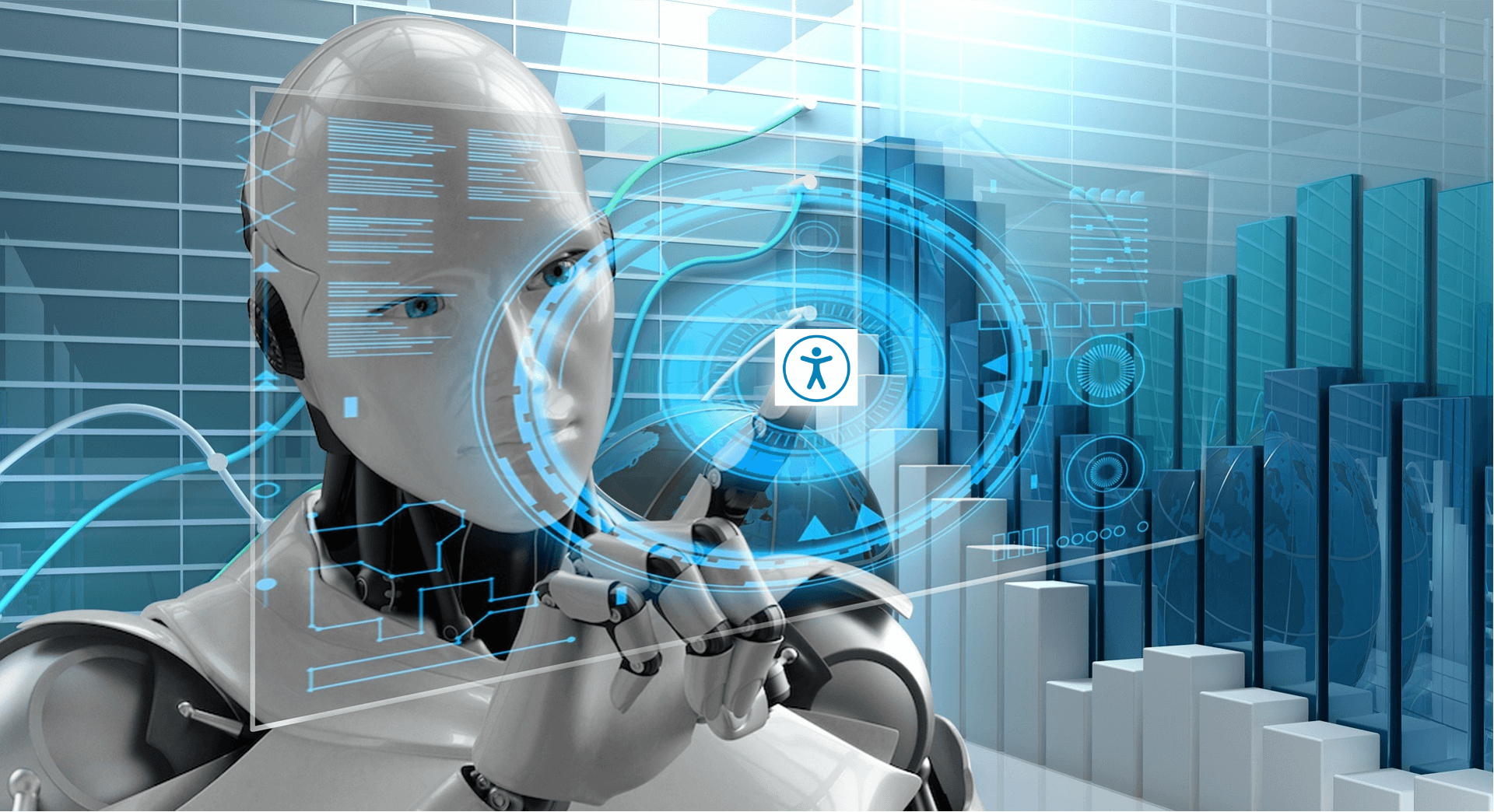Transforming the Digital Landscape for People with Disabilities
The advancement of automation and Artificial Intelligence (AI) has brought forth a new wave of innovation to various industries, including digital accessibility. Automation and its application are powerful solutions across many use cases. But perhaps most compelling, as a potential way to address accessibility at scale. Its potential to transform the digital landscape for people with disabilities is immense.
Opening doors to more inclusive, user-friendly online experiences at scale is becoming more and more possible. But most experts and persons with disabilities agree: We aren’t there yet. And some current solutions available presently can even add a layer of difficulty from an end-user perspective. Closed captioning created by AI isn’t perfect yet, for example. And, some website overlays, or as they can also be called, ‘widgets’ leave much to be desired. This is according to those with disabilities, and as referenced in statements by the National Federation for the Blind (NFB).
But that’s not to say that AI won’t be playing a much more prominent role in the future… in fact, it is starting to play a growing role more and more as we speak. The application of AI is here and now. The hope that AI presents in terms of scalability for everything, in particular, accessibility, is to many, an exciting prospect.
Today we can explore the role of AI in enhancing digital accessibility. Let’s highlight some of the groundbreaking applications making a difference in the lives of users with disabilities. We can also look at what lies on the horizon. In addition, we should dive into the availability of today’s solutions with built-in automation to address otherwise difficult tasks, like PDF accessibility for enterprise transactional documents.
AI for Digital Accessibility
Artificial Intelligence’s ability to learn is unprecedented, its demonstrated ability to adapt, and uncanny ability to process immense amounts of data positions it as an ideal tool for tackling digital accessibility. AI-driven applications have the power to analyze and interpret digital content and deliver it. The ability to deliver personalization is of high value for people with disabilities and is becoming more and more possible. Enabling people to access and engage with digital content more effectively, with adjustments and modifications to suit users’ unique needs and preferences in real-time is what the future looks like. There are many available advances out there today that are making waves.
AI Applications Transforming Digital Accessibility
Several AI-driven applications are revolutionizing the digital landscape for users with disabilities. Some notable examples include:
Automated Image Descriptions
AI algorithms can analyze images and are growing in their ability to generate accurate descriptions for visually impaired users. These descriptions, known as alternative text or “alt text,” (and when generated by AI it is referred to as AAT or ‘automated alt text), can be read aloud by screen readers. This can enrich the user experience by enabling users with visual impairments to understand the context (and content) of images. While there still appear to be some significant bugs to work out, it can be seen to be improving over time.
Natural Language Processing (NLP)
NLP techniques enable AI to understand and interpret human language, improving the capabilities of both text-to-speech, and speech-to-text applications. This technology creates benefits for users with hearing or speech impairments. It enables more effective communication with digital platforms and other users.
Predictive Text and Auto-Correct:
AI-driven predictive text and auto-correct features can improve the typing experience for users with mobility or cognitive impairments. These tools streamline the text input process, making it easier for users to express themselves and engage with digital content. While there are still numerous bugs to work out, (it can be bedeviling when autocorrect types nonsense) this tech is coming along.
Accessible Chatbots:
AI-powered chatbots can be designed with accessibility in mind, providing users with disabilities a user-friendly method to interact with customer support. It can also be seen to access information or perform various other tasks online. Accessible chatbots can be equipped with rich features like voice recognition, large fonts, and customizable interfaces to accommodate users with different needs. In the telecommunications field, the 1st layer of support on some of their websites appears to be chatbot-driven. There does appear, however, in many cases, to be some significant room for improvement in terms of the accessibility aspects. While becoming much more ‘human-like’, they are still a bit ‘buggy’. Thankfully, it appears that it is easy enough for the bot to pass the chat to a live agent, who can take over, should the bot be unable to address customer issues, or have trouble understanding.
The Evolution of AI and Digital Accessibility
Digital Accessibility continues to evolve as technology evolves. But along with it, we can see the evolution of the way people are using it. Thus, as AI continues to evolve, so too will its impact on digital accessibility. That said, it appears to still be in uncomfortable adolescence, Maybe it is experiencing ‘growing pains’. The advancement of automation does point to exciting possibilities. Both for today and in the future though, especially in the world of accessibility.
Organizations that want to create more inclusive digital environments that cater to the diverse needs of all users often find it difficult to achieve. What the roadmap would look like starts with the ability to integrate AI into digital accessibility efforts responsibly. It will require a lot of testing. It will need people with lived experience as a focal core of that testing and input. AI shows promise to one day enhance the user experience for people with disabilities but also drive further innovation. Here’s why: In its sheer scalability, AI may perhaps one day foster a more equitable digital landscape for everyone.
The Future of AI and Digital Accessibility
Indeed there is a growing role for automation. Especially in enhancing digital accessibility, and answering the call for the advancement of automation to handle bigger, more complex challenges. AI’s potential to revolutionize digital accessibility is immense. Many are working hard to create a world that empowers people with disabilities to access and engage with digital content on their terms. This ultimately fosters a more accessible and equitable digital future for all. But today the ability to do so at scale is lacking when it comes to the web at large. The ability to address every website on the internet and remediate every last one is an unachievable feat. It couldn’t be done the way it is achieved today, at scale. It would take decades and many, many more people. In fact, estimates say that the internet is growing by 250,000 new websites PER DAY!
Enterprise Transactional Documents Can Be Made Accessible at Scale… with Automation
In the same way, manual document remediation at scale is impractical. It would make transactional documents like bills, letters, notices, statements, and many other enterprise documents an impossible feat to remediate one by one. Meeting timelines in this scenario would be impossible. Most first-generation technologies available don’t meet the mark: they cannot meet the current required standards. Most require a lot of manual intervention or the use of costly professional services.
The newest generation approach, on the other hand, does meet the necessary standards. It uses automation to provide a “set it and forget it” remediation and validation process. It boasts the ability for organizations to operate independently, no longer needing constant manual intervention. Moreover, it eliminates the need for professional services from vendors or 3rd parties. The advancement of automation proposes a compelling path forward.
This approach addresses all types of enterprise digital documents. Even policy contracts, tickets, and passes before being released to the public. For organizations that care about security and ease of use, the newest generation solution for automated enterprise and transactional document accessibility makes great sense. It is on-prem, highly configurable, with a Rest API and an optional Workflow tool. You can even use an API to seamlessly convert archived historic PDFs into PDF/UA format. This includes on-demand during retrieval effortlessly by integrating it into your architecture. As customer needs grow and evolve, and as compliance standards and laws change, so too must technology. So too how organizations engage with their clients, customers and constituents. These too must become accessible. How to address it at scale is now here. The advancement of automation is here now.
Interested in how your organization can embrace technology to improve digital accessibility, and thereby elevate your brand? Contact us directly at ua@cdpcom.com – let’s chat!




